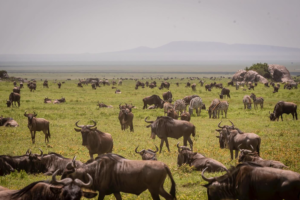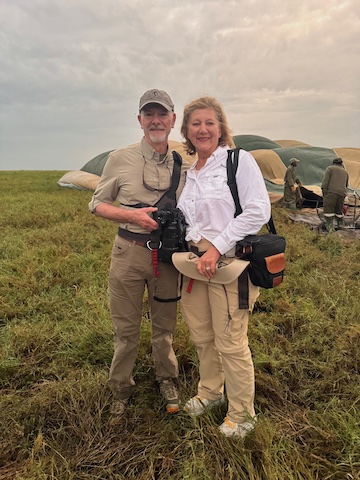Our Saturday morning class followed Robby’s photographs on his journey to Africa. I asked him to write a bit about his experiences for all of you. In his own words….
By Robby Summitt.

Earlier last month, from February 12 to February 23, my wife Margaret and I had the opportunity to travel to East Africa and spend 9 days on safari in Tanzania.
 We traveled as a group with the University of Tennessee Alumni Association (we both graduated from the University of Tennessee Center for Health Sciences in Memphis). Our experience is difficult to describe in words or photographs, but I will do my best.
We traveled as a group with the University of Tennessee Alumni Association (we both graduated from the University of Tennessee Center for Health Sciences in Memphis). Our experience is difficult to describe in words or photographs, but I will do my best.
Our safari took place during the time of The Great Migration, which is the largest animal migration on earth.
Over 1.5 million wildebeest and 800,000 zebra migrate through the Serengeti ecosystem in Tanzania and the Masai Mara ecosystem in Southern Kenya. Our window of time allowed us to be present during the birthing season of the wildebeest and zebra populations.
We then travelled to Olduvai Gorge, the archeological site for studying human evolution, and then to Ngorogoro Conservation Area, containing the Ngorogoro Crater which is the largest intact volcanic caldera in the world. The crater also holds the highest concentration of animals in Africa.
We saw many herds of elephants that make the crater home. In addition, we saw lots of hyenas, wildebeest and zebra, and only 2 rhinos. There were large flocks of African flamingos in the lake.  We finally traveled to Tarangire National Park and Lake Manyara. The Tarangire River runs through the park, and herds of elephants were seen traveling through and playing in the river. We had zebra grazing around our lodge tents at Lake Manyara.
We finally traveled to Tarangire National Park and Lake Manyara. The Tarangire River runs through the park, and herds of elephants were seen traveling through and playing in the river. We had zebra grazing around our lodge tents at Lake Manyara.
I know that I am leaving out so many sites that we saw, as one needs to actually be present in East Africa to truly understand the experience that it is.
Not only did we see thousands of adult and young wildebeest and zebra, but also saw cheetah, lions, a leopard, elephants, cape buffalo, rhino’s, wart hogs (pumba in Swahili), giraffes, monkeys and baboons, various antelope species, and many species of birds.
 Our travels took us through different geographic locations, with animal life distinct to each region. Through the Serengeti plains we watched The Great Migration. Early on our first day, we took a hot air balloon ride over the Serengeti, observing the beauty of the landscape and saw herds of elephants and buffalo, a pride of lions sleeping and several antelopes. A champagne toast welcomed us upon landing, along with an English Breakfast. That afternoon
Our travels took us through different geographic locations, with animal life distinct to each region. Through the Serengeti plains we watched The Great Migration. Early on our first day, we took a hot air balloon ride over the Serengeti, observing the beauty of the landscape and saw herds of elephants and buffalo, a pride of lions sleeping and several antelopes. A champagne toast welcomed us upon landing, along with an English Breakfast. That afternoon  and 2 additional days were spent traveling through the Serengeti.
and 2 additional days were spent traveling through the Serengeti.
The word “ajabu,” Swahili for awe, wonder and amazement, does not fully describe our visit.
I studied Swahili daily for 6 months prior to our trip. The local staff and guides were so welcoming when I spoke to them in Swahili, and had no hesitation in correcting me (kindly) when I spoke incorrectly. When visiting a local primary school in the Tarangire region, I spoke to the children in Swahili. They were so surprised that I was attempting to speak to them in their language.
As I mentioned earlier, we traveled with The University of Tennessee Alumni Association. In the past, we have typically just thrown the brochures for the Alumni Association away without looking at the trip that is being offered. For some reason, my wife held on to this brochure.
When she asked me if I was interested in going, I first asked if she was serious. Then, I enthusiastically said yes.
As an amateur wildlife photographer, this was a dream come true. I never imagined that I would ever go to Africa, but fate must have made us keep this offering. If fate brings you something like this, jump at it.

